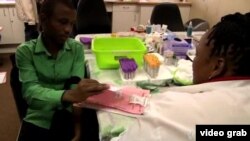HARARE —
Despite being sexually active as well as vulnerable to rape and other forms of sexual abuse, disabled people say they are overlooked in national HIV prevention strategies because policymakers do not perceive them as sexually active.
The Disability HIV and AIDS Trust has worked extensively to explore challenges faced by people with disabilities when accessing health, particularly HIV and AIDS services. It says most of the challenges stem from commonly held misconceptions among health personnel that people living with disabilities are not sexually active.
The organization says government initiatives to stop new HIV infections continue to sideline people with disabilities with the National AIDS Strategic Plan for 2008 – 2015, not even mentioning a single strategy to address the challenges faced by the disabled community in curbing HIV and AIDS infection.
In a baseline study in 2012, the United Nations said HIV/AIDS and disability is an emerging issue and cause for concern as people living with disabilities are at a higher risk of exposure to HIV infection due to social exclusion and rejection.
The report noted that apart from being excluded from national HIV and AIDS programmes, the disabled also often face lack of confidentiality at voluntary counselling and testing centres due to the presence of an interpreter.
Jessie Dube, a nurse, says the health delivery system has no policy or programme to equip caregivers with the skills and knowledge needed to effectively assist disabled people in HIV prevention.
She says added to this, most health care centres are inaccessible to disabled people, leaving them at the mercy of relatives and strangers in order to access services.
Dube adds that most people with disabilities are vulnerable to sexual abuse which makes it even more critical for them to be part of national health strategies which focusing on HIV prevention.
Daniel Moyo, is wheel chair bound following a polio attack when he was young. He says to most people in the disabled community, HIV is a death sentence. He says there is need for government to provide reliable information on HIV for people living with disabilities as they get most of their information from peers.
The Women and AIDS Support Network is another non-governmental organisation which works with people living with disabilities.
Programme coordinator, Anna Penduka, says they are struggling to provide information on HIV for people living with disabilities such as sign language and braille due to lack of money.
Organisations advocating for disability rights have challenged government to use human rights based interventions for the disabled people living with HIV, saying the Disability Grant, which is the only funding from government, is inadequate and the process of acquiring it is cumbersome.
According to the National Association of Societies for the Care of the Handicapped, Zimbabwe has a population of almost 1.8 million people living with disabilities.
The Disability HIV and AIDS Trust has worked extensively to explore challenges faced by people with disabilities when accessing health, particularly HIV and AIDS services. It says most of the challenges stem from commonly held misconceptions among health personnel that people living with disabilities are not sexually active.
The organization says government initiatives to stop new HIV infections continue to sideline people with disabilities with the National AIDS Strategic Plan for 2008 – 2015, not even mentioning a single strategy to address the challenges faced by the disabled community in curbing HIV and AIDS infection.
In a baseline study in 2012, the United Nations said HIV/AIDS and disability is an emerging issue and cause for concern as people living with disabilities are at a higher risk of exposure to HIV infection due to social exclusion and rejection.
The report noted that apart from being excluded from national HIV and AIDS programmes, the disabled also often face lack of confidentiality at voluntary counselling and testing centres due to the presence of an interpreter.
Jessie Dube, a nurse, says the health delivery system has no policy or programme to equip caregivers with the skills and knowledge needed to effectively assist disabled people in HIV prevention.
She says added to this, most health care centres are inaccessible to disabled people, leaving them at the mercy of relatives and strangers in order to access services.
Dube adds that most people with disabilities are vulnerable to sexual abuse which makes it even more critical for them to be part of national health strategies which focusing on HIV prevention.
Daniel Moyo, is wheel chair bound following a polio attack when he was young. He says to most people in the disabled community, HIV is a death sentence. He says there is need for government to provide reliable information on HIV for people living with disabilities as they get most of their information from peers.
The Women and AIDS Support Network is another non-governmental organisation which works with people living with disabilities.
Programme coordinator, Anna Penduka, says they are struggling to provide information on HIV for people living with disabilities such as sign language and braille due to lack of money.
Organisations advocating for disability rights have challenged government to use human rights based interventions for the disabled people living with HIV, saying the Disability Grant, which is the only funding from government, is inadequate and the process of acquiring it is cumbersome.
According to the National Association of Societies for the Care of the Handicapped, Zimbabwe has a population of almost 1.8 million people living with disabilities.





